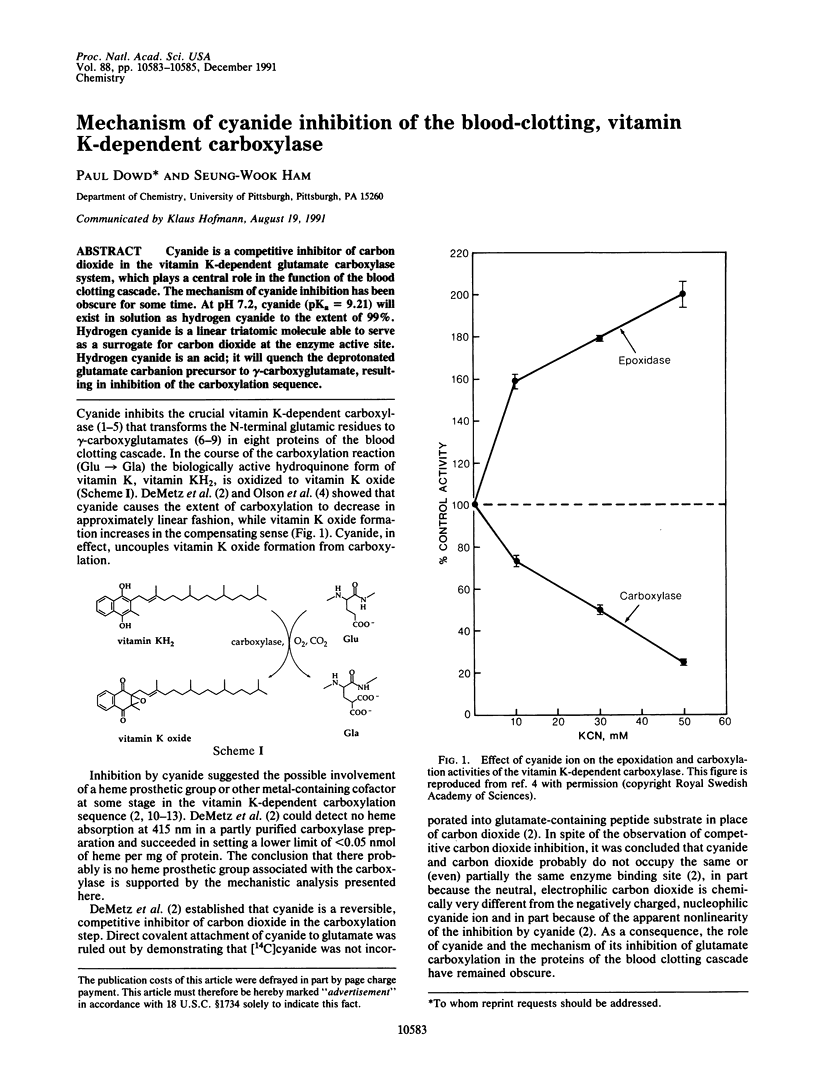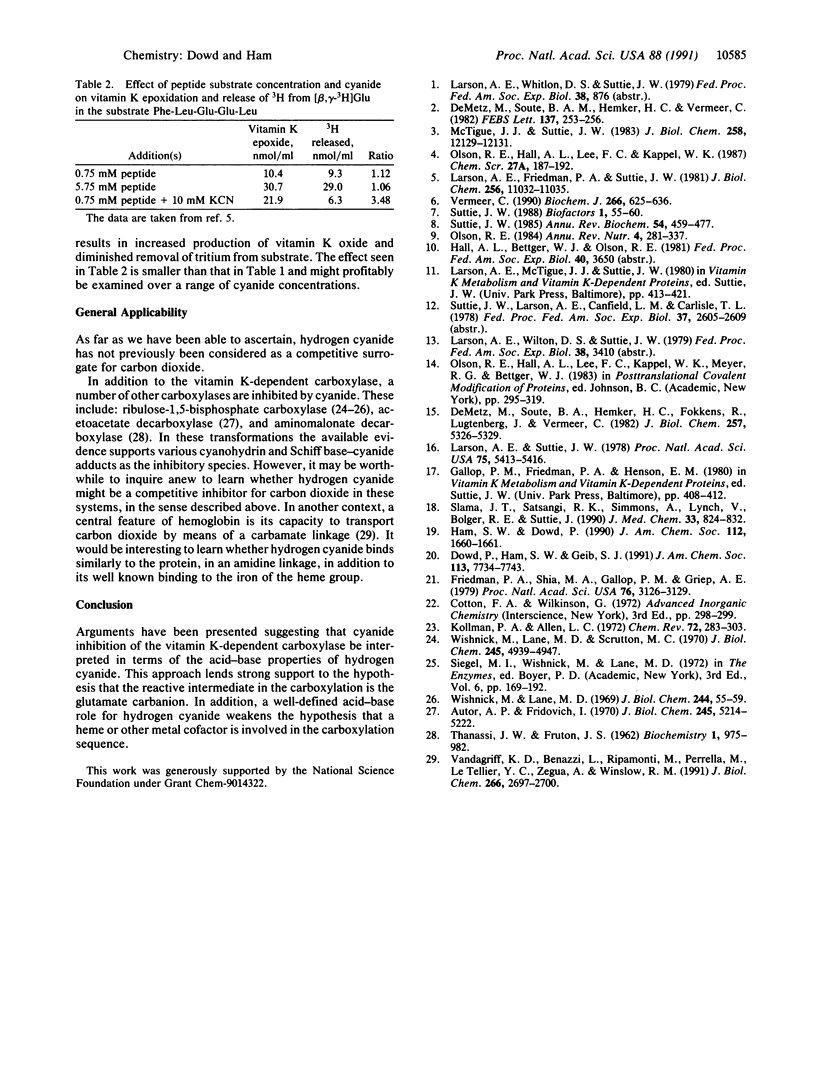Abstract
Cyanide is a competitive inhibitor of carbon dioxide in the vitamin K-dependent glutamate carboxylase system, which plays a central role in the function of the blood clotting cascade. The mechanism of cyanide inhibition has been obscure for some time. At pH 7.2, cyanide (pKa = 9.21) will exist in solution as hydrogen cyanide to the extent of 99%. Hydrogen cyanide is linear triatomic molecule able to serve as a surrogate for carbon dioxide at the enzyme active site. Hydrogen cyanide is an acid; it will quench the deprotonated glutamate carbanion precursor to gamma-carboxyglutamate, resulting in inhibition of the carboxylation sequence.
Full text
PDF


Selected References
These references are in PubMed. This may not be the complete list of references from this article.
- Autor A. P., Fridovich I. The interactions of acetoacetate decarboxylase with carbonyl compounds, hydrogen cyanide, and an organic mercurial. J Biol Chem. 1970 Oct 25;245(20):5214–5222. [PubMed] [Google Scholar]
- De Metz M., Soute B. A., Hemker H. C., Vermeer C. The inhibition of vitamin K-dependent carboxylase by cyanide. FEBS Lett. 1982 Jan 25;137(2):253–256. doi: 10.1016/0014-5793(82)80361-x. [DOI] [PubMed] [Google Scholar]
- Friedman P. A., Shia M. A., Gallop P. M., Griep A. E. Vitamin K-dependent gamma-carbon-hydrogen bond cleavage and nonmandatory concurrent carboxylation of peptide-bound glutamic acid residues. Proc Natl Acad Sci U S A. 1979 Jul;76(7):3126–3129. doi: 10.1073/pnas.76.7.3126. [DOI] [PMC free article] [PubMed] [Google Scholar]
- Larson A. E., Friedman P. A., Suttie J. W. Vitamin K-dependent carboxylase. Stoichiometry of carboxylation and vitamin K 2,3-epoxide formation. J Biol Chem. 1981 Nov 10;256(21):11032–11035. [PubMed] [Google Scholar]
- Larson A. E., Suttie J. W. Vitamin K-dependent carboxylase: evidence for a hydroperoxide intermediate in the reaction. Proc Natl Acad Sci U S A. 1978 Nov;75(11):5413–5416. doi: 10.1073/pnas.75.11.5413. [DOI] [PMC free article] [PubMed] [Google Scholar]
- McTigue J. J., Suttie J. W. Vitamin K-dependent carboxylase. Demonstration of a vitamin K- and O2-dependent exchange of 3H from 3H2O into glutamic acid residues. J Biol Chem. 1983 Oct 25;258(20):12129–12131. [PubMed] [Google Scholar]
- Olson R. E. The function and metabolism of vitamin K. Annu Rev Nutr. 1984;4:281–337. doi: 10.1146/annurev.nu.04.070184.001433. [DOI] [PubMed] [Google Scholar]
- Slama J. T., Satsangi R. K., Simmons A., Lynch V., Bolger R. E., Suttie J. An approach to trapping gamma-glutamyl radical intermediates proposed for vitamin K dependent carboxylase: alpha,beta-methyleneglutamic acid. J Med Chem. 1990 Feb;33(2):824–832. doi: 10.1021/jm00164a056. [DOI] [PubMed] [Google Scholar]
- Suttie J. W., Larson A. E., Canfield L. M., Carlisle T. L. Relationship between vitamin K-dependent carboxylation and vitamin K epoxidation. Fed Proc. 1978 Oct;37(12):2605–2609. [PubMed] [Google Scholar]
- Suttie J. W. Vitamin K-dependent carboxylase. Annu Rev Biochem. 1985;54:459–477. doi: 10.1146/annurev.bi.54.070185.002331. [DOI] [PubMed] [Google Scholar]
- Suttie J. W. Vitamin K-dependent carboxylation of glutamyl residues in proteins. Biofactors. 1988 Jan;1(1):55–60. [PubMed] [Google Scholar]
- THANASSI J. W., FRUTON J. S. Aminomalonic decarboxylase. Biochemistry. 1962 Nov;1:975–982. doi: 10.1021/bi00912a006. [DOI] [PubMed] [Google Scholar]
- Vandegriff K. D., Benazzi L., Ripamonti M., Perrella M., Le Tellier Y. C., Zegna A., Winslow R. M. Carbon dioxide binding to human hemoglobin cross-linked between the alpha chains. J Biol Chem. 1991 Feb 15;266(5):2697–2700. [PubMed] [Google Scholar]
- Vermeer C. Gamma-carboxyglutamate-containing proteins and the vitamin K-dependent carboxylase. Biochem J. 1990 Mar 15;266(3):625–636. doi: 10.1042/bj2660625. [DOI] [PMC free article] [PubMed] [Google Scholar]
- Wishnick M., Lane M. D. Inhibition of ribulose diphosphate carboxylase by cyanide. Inactive ternary complex of enzyme, ribulose diphosphate, and cyanide. J Biol Chem. 1969 Jan 10;244(1):55–59. [PubMed] [Google Scholar]
- Wishnick M., Lane M. D., Scrutton M. C. The interaction of metal ions with ribulose 1,5-diphosphate carboxylase from spinach. J Biol Chem. 1970 Oct 10;245(19):4939–4947. [PubMed] [Google Scholar]
- de Metz M., Soute B. A., Hemker H. C., Fokkens R., Lugtenburg J., Vermeer C. Studies on the mechanism of the vitamin K-dependent carboxylation reaction. Carboxylation without the concurrent formation of vitamin K 2,3-epoxide. J Biol Chem. 1982 May 25;257(10):5326–5329. [PubMed] [Google Scholar]


